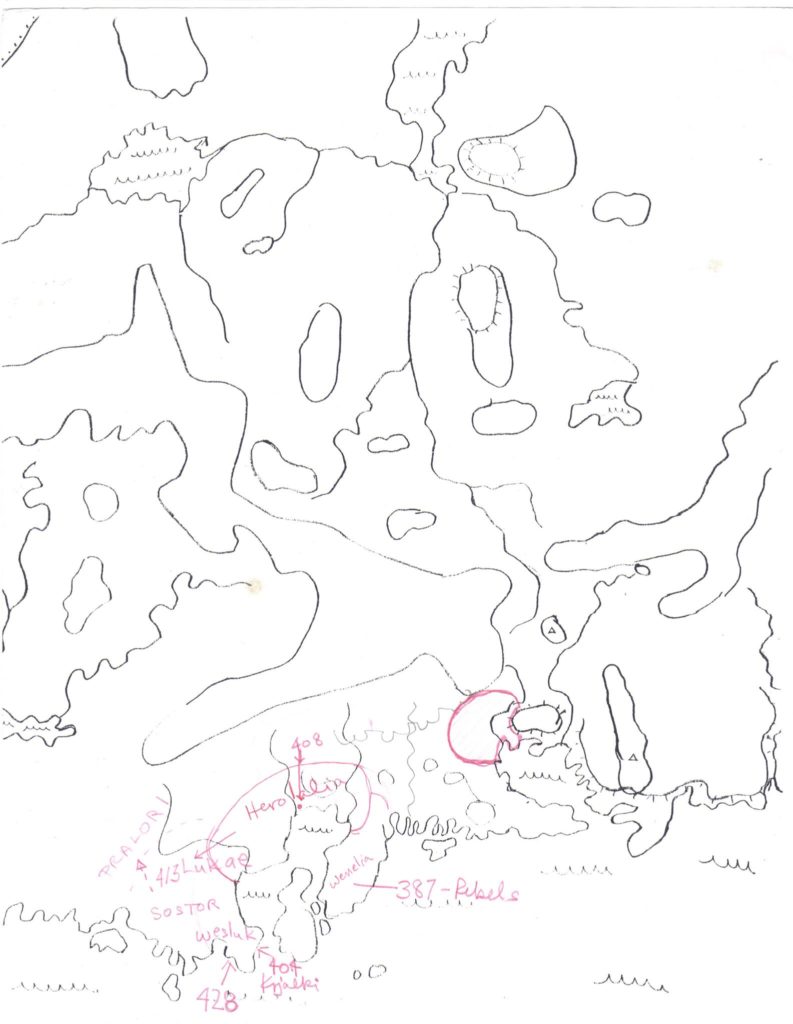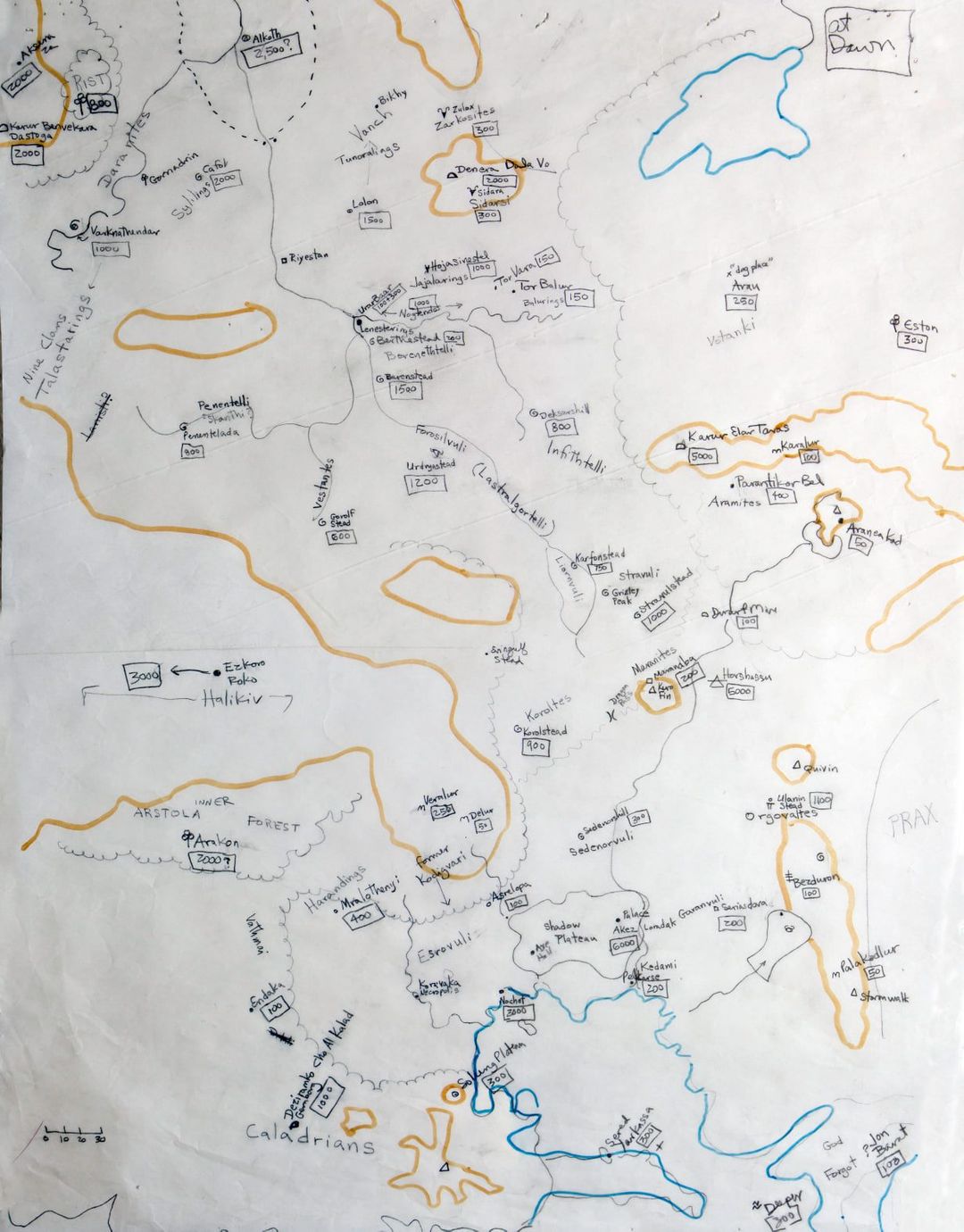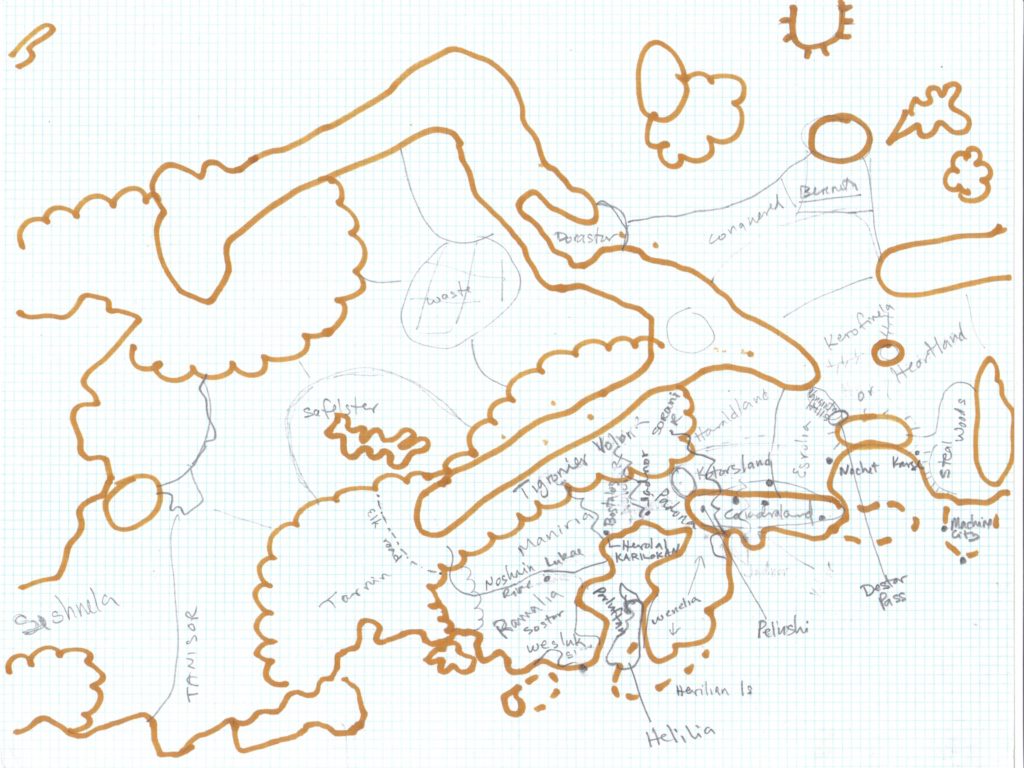Kethaela is an ancient name for the region now called the Holy Country. The land was named for the goddess Ketha, the wife of Entru and mother of Entruli, who came from this region but left for the West. There are many myths of this area and its creation. These myths include the making of the Mirrorsea, Ezel, the Footprint, the Stormwalk Mountain, the Palace of Black Glass, the Shadow Plateau, the Vent, and many other minor places.
The history of the region boasts a period between the Unity Battle and the Dawn called the Silver Age to mark its increasing splendor. Under the guidance of the Only Old One, the many races and tribes of Kethaela and Dragon Pass formed a council to speak to each other and work out the problems of their mutual defense. This was the Unity Council, or, as it is sometimes known, the World Council of Friends. At the Dawn, the peoples of the Unity Council spread throughout the world bringing the news of the Lightbringers to people still in hiding. At first even the Elder Races cooperated with each other, as they had in the Unity Battle, but eventually the unity weakened.
The dwarves of Gemborg were the first group to dissent. Their leader, Martaler of the Blazing Forge, and the Only Old One fought hand to hand, and the Only Old One proved he was no troll, for iron did not burn him. But the Mostali master still rebelled, and his human followers used volcanic powers from their area to drive off troll armies in 123.
Despite such occasional setbacks, the Dawn Council sent many missionaries and peoples out into the world to free them from the fear and ignorance which spread everywhere during the Darkness. Parties from Kethaela set off westwards into the lands of the Entruli and the Pralori with mixed success. These people were famed for their hatred and violence. It was only when King Lalmor set off with his tribe, the Vathmai, and reached Slontos in 115 that the Lightbringers were firmly entrenched into the culture of the region.
In the First Age, Kethaela was commonly known as the Shadowlands. The Only Old One preferred to surround himself with trolls, who loved him most dearly. To outsiders, trolls seemed to rule this land. Merchants rarely penetrated inland past the coastal cities of Nochet and Karse, and Goldentongue merchants spun haunting tales of wild Dragon Pass, deeper in the mountains. In the contemporary maps made by sea-goers, all the areas beyond Dragon Pass were labelled “Krjalki,” a Western word meaning “chaos monster” or “demon.” The map makers never visited there, but heard only stories of Lightbringers who hated the distant Pelorians.
The Shadowlands were a brooding and menacing entity for peoples who sailed past this coast. The trolls treated fairly with any ambassadors who came to them, but official policy was to defend the region against the forces which might come from the south. The trolls had no delusions about being able to expand into the lands of Slontos, while the humans there had no grandiose or foolish ideas about moving against a land ruled by trolls where the light did not work right and whose humans claimed a friendship with the dragons that lived in the north.
The Waertagi were the common boat people on the sea, and found eager allies in the Mirrorsea. The Triolini there preferred their watery cousins (the Waertagi) to the Only Old One, a male demi-god who was a son of Argan Argar. The Only Old One thereby lost a valuable subject but gained a loyal ally. The Waertagi asked to set up some trading ports in the area which were graciously allowed.The island peoples thrived tending to the coastal commerce of the region. They never developed any major cities of their own but instead had a loose confederation of islanders who elected an annual Son of Choralinthor who dealt with the shipping authorities in Slontos for tribute and hiring.
When the High Council of the Lands of Genertela sought to create a new god, the trolls and Heortling tribes left, resulting in the Broken Council. The Only Old One remained loyal to the trolls, and armies from Kethaela were among those which opposed Gbaji and were defeated at the Battle of Night and Day in 379. Kethaela was conquered by the Broken Council’s forces and placed under the rule of Palangio the Iron Vrok, a cruel warrior backed up by terrible magic. Despite great efforts, Palangio never succeeded in destroying the Only Old One and his Palace of Black Glass. Though there were some bandit groups, such as the Hendriki, who evaded capture, the rule of Palangio was largely complete and peaceable. Great caravans and armies marched from Kethaela to bring the bright word of Chaos to Slontos and beyond. In Dragon Pass, Harmast Barefoot gathered allies and, in 420, became the first mortal to follow in Orlanth’s path and travel the Lightbringers’ Quest. The strength of the Iron Vrok weakened in 432 when distant Slontos fell to the approaching army of Arkat Chaosfoe. The Waertagi had been raiding sporadically throughout the period, but now the raids were bolder and came more often.
When Arkat and his main army arrived in 433 to liberate Kethaela, he was opposed by a great force, though less than Palangio had hoped. Many of his subjects stayed away, such as the volcano priests of Caladraland; or were occupied by other foes such as the Hendriki in the Storm Hills, the Slontos army to the west, or the trolls who seemed to be everywhere. Arkat’s landing was successful, the dwarfs retreated to Gemborg, and Palangio was forced north toward Dragon Pass.
Arkat the Heroquester had taken great pains to make his landing successful. He mastered the art of heroquester and demonstrated his great courage by undertaking the tasks again and again. He often visited the Other Side to speak to or return with the spirits and heroes of old. In Kethaela, for example, he summoned forth King Heort, Vogarth Strong Man, and Tessele the True, all Silver Age heroes who had vanished from life centuries ago.
By heroquesting, Arkat assured himself of superior knowledge, surprise, and regenerative strength for each step of his increasingly difficult campaign. To enter Dragon Pass, he mustered ancient allies of his Unbreakable Sword, and later he called forth all the troll heroes he could remember. With an army of Orlanthi and trolls, Arkat crossed the Dragonspine in 437 and continued his war into Peloria.
Arkat was no conqueror and tried to leave behind a stable government everywhere he went to ensure continued cooperation in his war against Chaos. The Only Old One was reinstated as ruler of his land and it was again called the Shadowlands.
![]()
![]()
Who is Vogarth Strong Man?
Vogarth was the Strong Man. He was huge, strong, and generally kind, but noted for his dull mind as well as his great power. He was the strongest man in the world.He did many great deeds. The Strong Man was always ready to engage in challenges of strength. A huge stone giant once came and threatened the Only Old One, who called for Vogarth’s help. He came running and cracked the stone giant with his hammer and saved the Only Old One. He threw a dragonship onto the Palace of Black Glass, and the trolls ate the Waertagi. Another time he challenged Jeri Babo, called the Immovable Person, and pushed him off his chosen place. Another time, he carried the wondrous Living Stone Tree from the Footprint to Queen Merngala’s palace. She took him as her husband for while, and had him build the walls around her city.
In modern Esrolia, his is a cult of oiled and perfumed bodybuilders, who work out in the buff in the plazas of every Esrolian cities. Pumping Bronze!
Now something that always gets overlooked is the importance of Slontos in early Kethaelan history. From something I have posted elsewhere:At the Dawn the Elk People, the children of Pralor, were the residents here. Their population was thin at first, but the relative ease of the Dawn Age allowed for population expansion in all directions. Clans and families migrated in all directions until they came into conflict with neighboring peoples.
The traditional foes lived to the south and were called the Entruli. These were a branch of the Mraloti, or boar-folk, who had survived the Darkness in relative strength and delivered their civilization to their cousins after the sun rose. Thus, the Entruli ruled all of the peoples to the south.
The Entruli valued their civilization highly and looked with contempt on their neighbors. They coveted the lands inland from their civilization, and were happy to combat the Elk People for it. The Pralori, in their turn, were glad to gain the wealth of civilization through plunder rather than work. Thus, the region quickly reverted to the combats and troubles off the Darkness, as if nothing had changed since the Gods War.
In the year 97, the Entruli did what the Pralori could never do. Their ruler broke an ancient taboo which angered the gods. A great flood came rushing upon the land, drowning everything in its way and destroying the land. Only the capital, Porluftha, escaped because a Kolat clung madly to the buildings and held firm as the water washed over him. The city and its ancient inhabitants were preserved in a great air bubble undersea, lost to the outside world, undiscovered for many years.
Without their traditional dynasty, the Entruli treated each other like foes. The Pralori plundered often, the Entruli destroyed each other’s strongholds, and it seemed as if a powerful Elk person would become leader here easily.
Instead, there came a leader who was related to the old Entruli dynasty. He and his tribe came from the Shadowlands, where the Only Old One ruled over a nation of trolls and subject populations. A time had come when the Only Old One offered many of his subjects their freedom if they left his lands, or else commanded them to accept his rule.
The leader was named Lalmor, and his tribe were the Vathmai. He united the Entruli, helped them rebuild their strongholds, and led them to a great victory in driving off the Pralori. He arrived in 115, was finished with his victories by 122, and died in 138.
King Lalmor’s arrival was more than simply a unification of the Entruli peoples. He brought a new religion with him, and he was also aided by many inhuman peoples. Lalmor came from Dragon Pass, where the Unity Council had been formed and where they worshiped the world-saving Lightbringers. Lalmor brought worship of Orlanth and his pantheon. With these new cults he was clearly ascendant.
When the Lightbringer missionaries left the coastal Entruli lands and moved to enlighten the Pralori they were, in general, well received. The Pralori recognized the superiority of the new gods over their own animistic spirits. It did not unify the tribe, not did it split it.
The Lightbringers faith did not ensure the unity of the Entruli. After the death of Lalmor in 122 the Entruli heirs divided his lands into several kingdoms. Some were coastal and thrived upon the increasing sea-trade borne by the ship-living Waertagi race which ruled the surface waters. Some were buffer states between the coastal cities and the inland barbarians. Others were barbarian kingdoms living in woods and plains.
The Entruli and Pralori mixed in many places, blurring their original tribes and creating peoples who did not worship the animal gods Entru or Mralota or Pralor. These nations took the names of their kingdoms, such as the Ramalians and Wenelians and Manirians. In Pralorela the people continued to be called that ancient name through the whole period.
The Pralori first contacted the cult of Nysalor when missionaries from the north brought word and gifts of their new god. Like many places in the world, Pralorela was being swept by an awful plague which devastated the people. The Nysalor missionaries could heal it, and they could also cure many other ills. The Pralori were quick to adapt to the cult, and its subsidiary gods.
The Nysalorean Pralori united under the religion, and they also chose to worship the gods who were friendly to Nysalor. Thus, the cult of Yelm gained an ascendancy among the Pralori which it had not enjoyed before. Some allies, most adventurous mercenaries, were gained from norther peoples from Ralios. The Yelmite Pralori attacked the southern kingdoms, and there began another long and terrible war. Some of the Vathmai nations also embraced Nysalor, and the Pralori claim that these southerners were the first to use the Dark Side of their god to gain their own ends. This is discounted by most scholars, but it is certain that this whole region was embroiled in an increasingly difficult and vile war. One instance is recorded of a Nysalorean army meeting a Gbaji army on the field, and in the fight everyone was killed except the priests of both cults.
Pralori armies aided Tanisor, a leading nation of Ralios, when they fought against Arkat, an enemy invader from a distant land. The Pralori army, like so many others, was crushed.
Eventually the forces of Gbaji the Deceiver gained the upper hand. Many Chaos creatures, especially the vile broos, were increasing in the land. People seeking a decent way of life were driven to a smaller and smaller region. Kaxtorplose, the sacred city of the demigod Kaxtor, was one of the last places which remained untainted by Chaos as the wars raged. Thus Ralios fell to the cleansing armies of Arkat but the Pralori and Entruli were all but devoured.
Arkat’s cleansing scourge went far and wide. He arrived in Pralorela by land and sea, in Waertagi ships carrying Seshnegi and Brithini troops, and in great columns of Lightbringer barbarians from Ralios who follow the Unbreakable Sword. They concentrated on relieving Kaxtorplose, and then on liberating the centers of coastal population. Some Pralori, huddled among the refugees of Kaxtorplose, agreed to help convert their people away from the evil god. They were aided by the remnants of the coastal population in this. Their main gods were the Lightbringers, who refused all contact with the gods of Light and of Chaos, and also the religion of Malkion in its Brithini and Seshnegi form.
The cleansing of Pralorela was never as complete as anyone wished. When Arkat slew Gbaji in 450 and ended the cosmic battle, this land was still plagued. The natives did their best, but the broos could always find refuge in the marshes, and the natives were never dominant enough to force a final solution. The region became popular for all peoples seeking Chaos to destroy, and who had the time and courage to search the treacherous marsh. Many Pralori were proud to be among those hunters over the generations, and they were also experts at marsh survival and so gained great local fame and riches.
The end of the First Age saw the region little-changed from the Dawn. The people were slightly more educated in the ways of the cosmos and new gods were worshiped. They owned some manufactured goods, plundered from the coast and handed down over the generations, but they had no great cities of their own, nor any inspired leaders to lift them from their squalor. But the people were not unhappy, and lived good lives when they were not harassed by enemies.
This is a fascinating map that shows how interconnected those areas were. Caladraland extended to the Pelushi Volcano and served as a buffer between Wenelia and Esrolia. “Haraldland” is now the Old Woods and Longsiland, and Kotorsland is what is now the Ditali and Thomble.
A Lightbringers dynasty ruled in Herolal and Wenelia, originally from the Unity Council lands.
But you can see how closely Esrolia and Caladraland are linked to this.
Now pay attention to Jadnor and the Volior River – this ends up being an important cultural mixing zone for the next thousand years.
Now Herolal gets conquered by the Broken Council around 401, and Maniria by 413. These campaigns were, I believe, spearheaded by Palangio the Iron Vrok. A crazy period when Dara Happan mystics commanded armies with Storm cultists, dragonewt mercenaries, iron dwarfs, and elf bowmen.

What’s the origin of these maps? These were all part of the research Greg did into his Harmast story. Greg ended up writing more about the First Age than he did about the Third.


